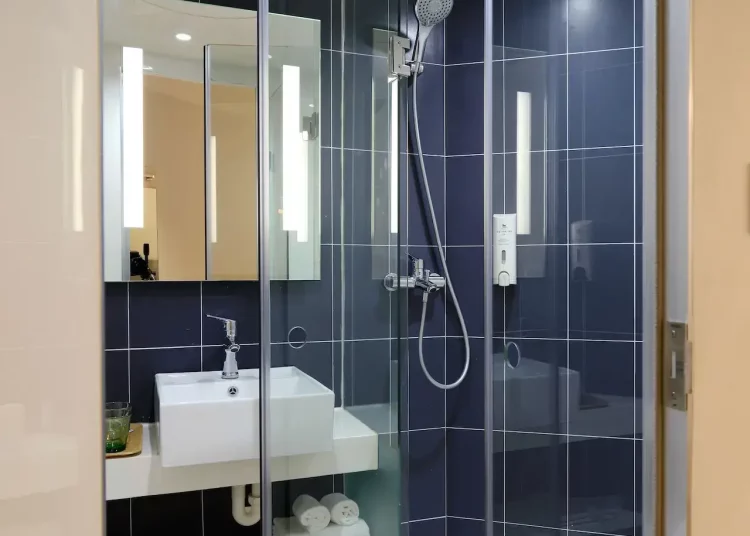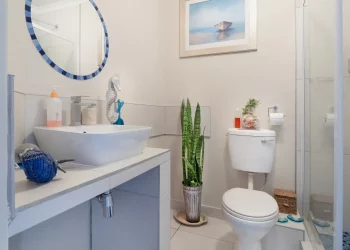Operating a shower may seem easy if you’re not a plumbing expert.
You just turn on the water, lather with shampoo and soap, and rinse off under the water. However, sometimes things can go wrong and parts of the shower can stop working or cause the drain to clog.
To understand how showers work better, it’s important to learn about something called a shower valve. This controls the flow of water in your shower and ensures everything runs smoothly.
Where is the shower valve?
The location of the shower valve depends on the type of shower you have. If you’re dealing with a standalone unit or a bathtub that has a showerhead, there will be one or more valves that regulate water flow and temperature.
Sometimes, you’ll only need one valve to control both aspects, while other showers require two or more valves to manage how they work.
If your shower has multiple valves, they may come with handy labels like “H” for hot and “C” for cold. This can help you easily distinguish which valve does what.
Additionally, a third valve, a diverter valve, determines where the water flows from either through the bathtub spout or the showerhead.
You might be interested: How to Troubleshoot a Running Toilet Like a Pro
How does a shower valve work?
The way a shower valve works depends on the type of shower you have. In standalone showers, one valve typically controls both water flow and temperature.
You turn or pull out the handle to start the shower and then adjust the knobs to control how much hot or cold water flows from the spout.
Many newer showers also have safety devices that prevent scalding by controlling the water temperature. This is especially important for households with young children or older adults, whose skin can be more sensitive and easily burned by hot water.
These safety features help ensure everyone enjoys a comfortable shower experience.
Types of Valves
Buying a new shower usually comes with a special valve that helps control the water temperature and how much water comes out.
There are two main types of valves that you might see: pressure-balance and thermostatic valves.
Pressure-Balance Valves
Imagine you’re taking a shower, and suddenly, the water gets extremely hot, causing your skin to burn. Ouch! That’s where pressure-balance valves come into play.
These unique valves are specifically designed to regulate the temperature of your shower water and keep you safe. But how exactly do they work?
It’s all about controlling the flow of hot and cold water to ensure the temperature stays consistent. Adjusting a tiny screw on the valve allows you to set your desired temperature without worrying about getting burned.
And get this: even if someone else in your house turns on another tap or flushes the toilet (causing changes in water pressure), the pressure-balance valve automatically adjusts to maintain a safe temperature for you.
It detects when there isn’t enough cold water and reduces how much hot water comes out so that no one gets scalded by accidentally stepping into hot water.
So next time you hop in the shower, take a moment to appreciate your trusty pressure-balance valve for keeping you nice and comfy!
Thermostatic Valves
A thermostatic valve is a type of valve that helps you control the temperature of your shower water better than a pressure-balance valve. This system has two valves – one controls the flow of water, and the other controls its temperature.
Unlike a pressure-balance valve, which only adjusts water pressure, a thermostatic valve reacts to the actual temperature of the water.
Inside this valve, four components work together to control the water’s temperature: the thermostatic element, piston, return spring, and temperature control.
Here is a breakdown of each component:
- Thermostatic Element: This part senses the temperature of the water and expands or contracts based on it. This then signals other parts of the valve to adjust accordingly, ensuring that your shower maintains a consistent temperature.
- Piston: The piston controls how much hot and cold water flows into the valve. It moves up and down depending on how much hot or cold water is needed to achieve your desired temperature.
- Return Spring: A return spring is a small but important part of a valve that helps control the movement of the piston. It provides resistance to ensure the piston moves steadily, preventing any sudden or erratic movements.
- Temperature Control: Temperature control is another essential feature in valves, typically represented by a knob or lever. This control allows you to set and adjust your preferred water temperature by regulating how much hot or cold water flows through the valve. This way, you can always enjoy your shower or bath at just the right temperature.
Diverter Valves
Install a diverter valve if you want to add a shower to your bathtub. A diverter valve is a type of shower valve that controls where water flows in a shower/bathtub combination.
It doesn’t have anything to do with the water temperature. You can switch the water flow from the tub faucet to the showerhead.
There are three types of diverter valves you can choose from:
- 3-Valve Diverters
- Two-Valve Diverters
- Tee Diverters
3-Valve Diverters
A 3-valve diverter is a special valve found in shower/tub combinations. It has three settings that you can choose from by turning a handle. The first setting sends water to the showerhead, the second lets water flow out of the tub spout, and the third allows you to use both simultaneously.
Two-Valve Diverters
A two-valve diverter is a type of valve that can be installed in your bathroom. It helps you switch the water flow from the bathtub to the showerhead. This diverter has an L-shape and pushes water up to the shower arm.
You’ll typically find it between two taps controlling how hot or cold the water is. The dial on this valve usually has red for hot and blue for cold, so you know which way to turn it.
Tee Diverters
A tee diverter is a type of diverter valve built into the tub spout. It allows water to flow into the tub and mix well before diverting it to the showerhead.
To use this type of diverter, you simply pull up a knob to divert the water from the tub and up through the pipe to the showerhead.
Unlike other types of diverters, a tee diverter usually has only one valve for controlling the water flow.
This makes it easy and convenient to use but also means that you cannot control the temperature or pressure of the water separately.
You might be interested: How to Paint Your Bathroom Sink Using Rust-Oleum Tub and Tile Paint
Troubleshooting a Diverter Valve
If your plumbing system has a diverter valve, it’s important to ensure it works correctly. This valve directs water to different fixtures in your home, such as your showerhead or bathtub faucet.
However, if the diverter valve isn’t working properly, you might experience issues like low water pressure, leaks, or no water at all. Troubleshooting a diverter valve can be tricky, but don’t worry!
With the right tools and knowledge, you can figure out what’s going on and fix it quickly.
Low Water Pressure
If you’re experiencing low water pressure due to a malfunctioning diverter valve, you’ll need to take some steps to fix the issue. Gather the necessary tools like pliers, a screwdriver, and a small brush to start.
Begin by turning off the water supply to the valve and removing its handle. Next, use pliers to remove the retaining clip and pull the diverter from the valve body. Use a small brush to remove debris from the valve body and the diverter.
Once you’ve cleaned everything thoroughly, reassemble all the parts in their proper order and turn your water supply back on. This should help restore proper water flow through your plumbing system.
Leaks
If you notice that your diverter valve is leaking, it may be because a small piece called a rubber washer or O-ring is either broken or worn out. To fix this issue, you must remove the valve like you did when dealing with low water pressure.
Once you remove the diverter, search for the rubber washer or O-ring and carefully remove it with a small screwdriver. Replace it with a new one of the same size, assemble everything, and turn on the water again. This should solve any leaks in your plumbing system.
No Water
If you turn on your shower or bathtub faucet and no water comes out, it might be due to a faulty diverter valve. The valve can be damaged or worn out, there could be a blockage in the valve body or an issue with the water supply.
To solve this problem:
- Start by checking the water supply to the valve.
- Ensure that the water supply valve is open and that there are no blockages in the pipes leading to the valve. If that doesn’t work, disassemble the valve and examine it for any damage or blockages.
- Follow the same steps as when dealing with low water pressure by cleaning out debris and replacing damaged parts if necessary.
Incorrect Water Temperature
If you notice that the water temperature in your shower or bathtub is not always consistent, it could be due to a problem with the diverter valve. This valve helps direct water to the right place, but if it’s not functioning correctly, it can cause uneven temperatures.
To determine if this is the issue, check if the temperature is inconsistent throughout your home or just at one faucet. If it’s only one faucet, you may need to disassemble the valve and see if there are any blockages or damaged parts.
Like fixing low water pressure, cleaning out debris, and replacing broken parts as necessary. However, if the temperature fluctuates everywhere in your home, it might be due to an issue with your water heater instead of the diverter valve.
Stuck Diverter
A stuck diverter is another common issue with a diverter valve. This occurs when the diverter becomes stuck in one position, preventing water from flowing to other fixtures in your home.
Dirt or mineral deposits in the valve or a broken or worn-out rubber washer or O-ring could cause the problem.
To fix this issue:
- Start by turning off the water supply to the valve and removing the handle.
- Use pliers to remove the clip that holds the diverter in place and carefully pull out the diverter from the valve body.
- Check for any signs of damage or wear; if there are any, replace them.
- If not, use a brush to clean both the valve body and the diverter of any dirt or mineral deposits.
- Once cleaned, reassemble everything and turn on the water supply again.
Additional Tips: In-Spout Diverter Repair
If the diverter valve is difficult to repair, replacing it is the easiest way to fix it. Usually, a screw on the bottom of the valve holds it in place. You can use an Allen wrench to remove the screw.
For spouts that don’t have a set screw, you’ll need to use a pipe wrench to remove them. Turn the wrench counterclockwise until you’re able to remove the spout from the water pipe.
Take the spout with you when you buy a replacement to ensure the diverter is located in the same place. Once you’ve bought a replacement, install it by turning the wrench clockwise.
Sometimes, problems with pressure balance or thermostatic shower valves can be difficult to detect. Other issues can cause a lack of hot water, pipe debris, or reversed water temperatures from hot and cold taps.
You may need to hire a plumber to fix them in these cases, as they require more specialized knowledge and tools.
Conclusion
Troubleshooting a diverter valve can be challenging, but it can be easily fixed with the right knowledge and tools. Always remember to turn off the water supply before disassembling the valve and use appropriate tools to prevent any damage.
Following the step-by-step instructions outlined in this article, you can keep your diverter valve working correctly and ensure consistent water flow throughout your home.
With basic know-how and tools, you can avoid costly repairs and the inconvenience of a malfunctioning plumbing system.
If you’re still having trouble after troubleshooting, it’s best to call a professional plumber for assistance. They can diagnose the issue and make any necessary repairs to get your plumbing system back in working order.
Regular maintenance is essential in preventing issues with your diverter valve and other plumbing fixtures. Keeping your system clean and well-maintained can avoid costly repairs and ensure consistent water flow throughout your home.




















